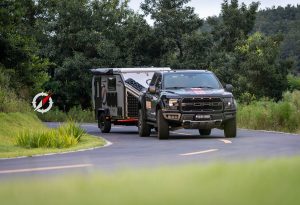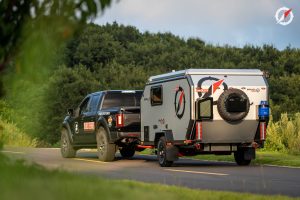Well, the biggest one is the one that you’ve done. If you look at many people towing fifth wheels in New England, if you look at their tailgate, you see many of them are dented because it’s extremely common for that to happen. When you’re putting your fifth wheel in here—so this will be your kingpin—if it goes in most of the way, but not all the way, it’s not fully locked. I don’t think I can do it by hand, but you need that to click and shut. Otherwise, it’s coming out either right then or sometimes it’ll go halfway and come out at an even worse time, like while you’re driving, which is even worse. So, make sure that’s in there. Ensure your pins are all in place because the safety pins are there for a reason. They’re going to keep it safe against the term.

Yeah, make sure that’s in there. One of the biggest questions with fifth wheels is, “Do I need a slider? Do I need a fixed hitch?” Many trailers or campers nowadays have more conical-shaped fronts, so you don’t necessarily need a slider because you can make tight turns. Sometimes, you still do, especially with the short beds—not the six or six-and-a-half-foot beds. You’re generally going to want a slider for shorter beds than that because the slider can actually go back too far and smack your tailgate again.
I’ve only seen it a few times, but it does happen. When these are back, and you’re making your tight turn, you pull that back to get your clearance from the cab to the front of your camper. That way, you won’t smack into the cab when you make your tight turn. I’ve seen it happen a few times where people don’t put it back into the towing position, and things get thrown off. The front of your truck will be raised up; things won’t be adequately levelled—it’s not good. When you’re done with your turn, get out and push this thing back into place. It has to be in the towing position when you’re towing, or bad things can happen.

This is easier because it typically doesn’t lock when you’re in your turning position. So, when you’re done with your turn, you can back your truck up, and you’ll feel it locking. It’ll be a good chunk when you return to your towing position. Like with this Curt here, it does lock in your turning position, so you have to get out, make sure it’s open again, and then back up so you’re back in your towing position. So, B & W is more straightforward with that.
Another one with fifth-wheel towing is, again, loading. Make sure you’re still loading front-heavy. You don’t want to load back-heavy on that because it’ll still pull up on the front. You can get there—there’s no weight distribution system for fifth wheels, so loading is a little more critical. So, you want to ensure you’re evenly loaded, a little front-heavy, and not too much on one side because it can cause sway issues. And when you’re getting sway issues in a fifth wheel, you’ll feel it in your truck because it will move you around. Generally, those are pretty heavy.
So, it’s a myth that you must load your fifth-wheel Trailer more in the back. I had a toy haulier—a big toy haulier—and you think, “Well, I want to reduce the weight on my rear, so I want to throw much stuff in the garage.” And so, that’s a myth.
Yeah, yeah, it is. It’s a common one. I don’t know how it started, to be honest, but it’s been perpetuated, and people do that. It’s better to be more front-heavy than back-heavy because it will give you a lot easier towing experience.
I understand where that part comes from. However, if you’re towing and loading up that heavy, you shouldn’t be loading that heavy on the truck anyway. These hitches, especially fifth wheels—even the less expensive options—will handle more than your truck probably can. Yes, you can upgrade your suspension a little bit. It will never increase your towing capacity, but it can help with the ride if you’re having ride issues. Upgrade your suspension if you’re starting to get the front end picking up a lot and getting much sag in the back. Still, load a little front-heavy on your trailer, and it’s perfectly fine.
We have a lot of different products for suspension upgrades. We’ve got simple, set-it-and-forget-it ones, airbags you can adjust to if you pull different weighted trailers. You can adapt it however you want. We’ve got a couple that are add-ons to your springs, and you can adjust them to where you want them. It’s another set-it-and-forget-it, but it’s easily adjustable if you ever need to. It’s the Road Active system. We’re getting many people interested in them because they are very easy to set up, relatively inexpensive as well, and they do a good job.

It’s not easy to do. Now, if you’re trying to reach over a truck bed and do that, it’s not easy to get that out because you have to take it out and turn it, and then you can move it.
This is more expensive because it is better made. It’s worth it. It’s a better product all around than everything else. Now, the Dico Auto Slides for the sliding options are slightly more expensive. They’re also American-made, which I like. You don’t have to do anything to turn them. So, instead of coming out here when it’s raining and having to do that to slide your hitch back, once your head turns to a certain point on the Auto Slide, it’ll automatically slide back with the Trailer. And then, when you’re done, it’ll straighten out and slide back. It’s a charming system. They’re generally not in everyone’s price range, but if you’re going to be a full-time tower, it’s a great option. And it is the best option if you’re a full-time tower.
This should probably be number two. Generally, full-time towers use these. They’re more for people who will be towing a lot, just not all the time. If you’re a beginning tower and you’re not going to be doing it very often, go with a less expensive option as long as you can work it. I like B&W, though.
Are there any other fifth-wheel mistakes?
Fifth wheels—there’s not as much to them when you’re hitching, so it’s a bit simpler. You want to ensure everything is secure and has the correct weight capacities because bigger can be better with these than weight distribution systems. So, if you’ve got an over-rate—say if you’ve got like the A20 here, which is rated to 20,000 lbs—if you’ve got a 15,000 lb trailer, no issue. Don’t go with a trailer of about 22,000 lb if you only have a 20,000 lb hitch. But as long as you’ve got enough capacity, everything’s locked in properly, and all your wiring is working well, you’re pretty much good to go with that.
So that was a big thing. Like, some people get super confident in their setup, and they stop doing that. I just was never taught it initially, so I never did. So, that’s it—it doesn’t hurt to do it. Okay, especially if you are new to it or getting into it. Obviously, you had the issue where you might have known quicker if you had done that. But it doesn’t hurt to do it. It’s not 100% necessary, especially if you’ve been doing it long enough that you know what it feels like when something makes the entire connection.
What are the mistakes that people make around pin boxes?
So, with pin boxes, you cannot necessarily make many mistakes with them. If you’re getting a new one, you want to ensure you have the correct weight capacity. One of the biggest ones we see here at Trailer when we’re getting phone calls, emails, or chats is that we don’t have a way to look up your bolt pattern with your VIN on your Trailer or any of the information. You either look at—there’s either a sticker on here that’ll tell you what you have, or you have to measure it to kind of figure out exactly what it is. We do have another way to figure out with measurements to determine exactly which one you have. But if you’re ordering a new pin box, you have to have the correct pin box number; otherwise, it won’t bolt up, and it can cause issues like you’ve got to return it. Generally, these ship freight because they’re cumbersome, so getting that fixed can cost much money. So, it’s something you want to get right the first time.
Again, there’s generally a sticker on it. If there’s no sticker, go to our website. There’s a way to measure it. We just take all the measurements you get, and we can tell you exactly what you’ve got. But pin boxes are straightforward. All the pins are the same size. There’s no variation of those at all. It is kind of an industry standard.
They’re easier to hook up. Yes, it’s a bit more complicated when you’re backing your truck up to figure out exactly where the ball is, but you drop your hitch onto that, and then it’s locked in place. Put your safety pin in, and you’re good. So, you don’t have to worry about any of this kind of stuff. It’s a lot easier. Many more people are switching to that because it is a significantly easier setup. And you don’t have to deal with a hitch anymore because if you want to put something in your bed now and have a fifth wheel, you either have to pick up these hefty products or work around it. With a gooseneck, all you’ve got to do is take the ball out and have an open bed. So, goosenecks are getting a lot more common for fifth-wheel conversions.
One thing to add with goosenecks is safety chains, even if switching to one of the Goose Box or the GY options. You have to have safety chains to attach to them because they are a little—I don’t know the right word for it—but you have to have safety chains.
And any mistakes that people make with the Goose Box safety chains?
People assume that since they’re switching from a fifth wheel to just the gooseneck ball, and since they still have the big old pin box, like, “I don’t need safety chains; I’ll be good.” You need safety chains, okay, for a reason. So, if that ever does—if you forget to latch it or something, and it ever comes off, and if you don’t have safety chains on there, you have destroyed your truck and camper, most likely. So, use them. You don’t have to cross the chains on a gooseneck but want safety chains.